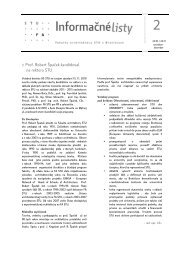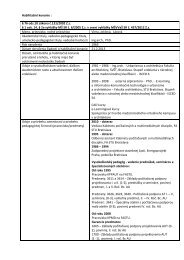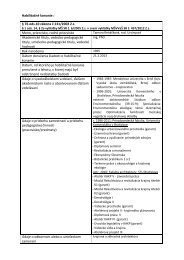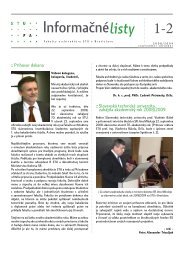ALFA 3-4/2005 - Fakulta architektúry STU
ALFA 3-4/2005 - Fakulta architektúry STU
ALFA 3-4/2005 - Fakulta architektúry STU
Create successful ePaper yourself
Turn your PDF publications into a flip-book with our unique Google optimized e-Paper software.
Ročník 9<br />
3-4 / <strong>2005</strong> ARCHITEKTONICKÉ LISTY FA <strong>STU</strong><br />
- Reduced stress levels among staff<br />
- Attraction and retention of quality staff<br />
- Increased level of hospital attractiveness<br />
- The positive impact on recruitment of nurse.<br />
Hospitals in Slovakia<br />
The problem with Slovak hospitals is that most of them are not<br />
very hospitable. After the fall of socialism we inherited a lot of<br />
hospitals, which are presently in insufficient conditions.<br />
Currently if you are a first-time patiegroups, like the nursing<br />
department, the outpatient department and the treatment and<br />
examination departments are located next to each other, so they<br />
are not dependent on each other. That offers give more<br />
opportunities for flexibility of hospitals in the future. The current<br />
Slovak health care system has to solve difficult financing problems<br />
what has also the main influence on obsolete architectural solution<br />
and insufficient amenities of hospital buildings. The Slovak<br />
Republic has decided to reinstall system of statutory health<br />
insurance after the fall of communism. Such a decision has been<br />
influenced by historical experience before 1948 nt, for example,<br />
you may already be feeling fairly anxious when you arrive at<br />
the hospital car park. So if you cannot even find the main entrance<br />
because it is badly signposted, or if, once you have got into<br />
the building, you cannot find the department you want, your<br />
anxiety level will probably increase. And if, during your<br />
wanderings, you pass through corridor after corridor choked with<br />
beds, trolleys and bags of waste, you are going to start wondering<br />
whether a hospital that can let its public spaces get into this state<br />
is really going to look after you properly.<br />
The situation is largely due to a historical lack of design<br />
awareness in the socialist countries, resulting in hospital<br />
designers often putting functional efficiency before everything<br />
else. However, this has meant that Slovak hospitals have<br />
sometimes been designed for the convenience of staff rather than<br />
patients, and design features that might have made the patients<br />
feel more at home have been neglected. This design reflects<br />
the culture of the socialistic system, where patient is not an<br />
individual person with different requirements, but one part of an<br />
impersonal group. The problem has been made worse by<br />
the growth in demand for hospital care. Buildings that were<br />
unfriendly designed in the first place have become even more<br />
inhospitable because the spaces are not used efficiently and<br />
adaptation for new conditions is very difficult, because of<br />
unsuitable layout. We have now reached a position where far too<br />
many hospitals succeed in making people feel worse than they did<br />
when they came through the main entrance. Materials used in that<br />
period were of low quality. The structure of the buildings cannot be<br />
used easily for other purposes. Up ‘till now should be renovated<br />
some of those buildings completely and some should be pulled<br />
down.<br />
Organisation of hospitals in Slovakia was mainly based on<br />
the classical organisational model according to medical specialist<br />
- 34 -<br />
departments and separate centralized diagnostic and medical<br />
treatment facilities. Due to the mainly overall-disciplinary<br />
approach, nearly every specialism had the same beds within<br />
the nursing departments and the same facilities at the outpatient<br />
department.<br />
This resulted in different types of hospitals like:<br />
The mono-block type<br />
The pavilion type<br />
The comb type<br />
The passage type<br />
The atrium type<br />
The branching type.<br />
Very apparent over the past years is that the nursing departments<br />
have moved from the centre, the heart of the hospital to<br />
the periphery. If you compare the mono-block model, with<br />
the nursing departments in the high storey central section of<br />
the building, with the newer branching-type models, where<br />
the nursing departments have moved to the periphery and<br />
the diagnostic and treatment facilities in the centre, it is clear that<br />
design has followed medical developments and practice.<br />
Most of the hospitals from the past 30 years didn’t put enough<br />
emphasis on flexibility, because the developments in healthcare<br />
weren’t as fast as the technical lifetime of hospital buildings.<br />
The branching-type buildings show examples of flexibility in which<br />
the main function and by example of neighbouring Germanspeaking<br />
countries. It also represented an understandable<br />
reaction to the shortages of communist national health system.<br />
Suggested changes in roles of institutions will lead to efficiency<br />
improvements. Main forces leading to desired changes will be:<br />
• Increased financial responsibility of payers and<br />
providers stemming from their new legal status.<br />
• Competition among price providers and awareness of<br />
patients will lead to restructuring of provider’s offers and<br />
increase of their productivity.<br />
The proposed reform of financing will support changes through<br />
pressure of Consumers. Citizens equipped with finances from<br />
their personal health accounts and with information on provider<br />
and payer performance will select and use health care best<br />
responding to their needs. All these changes have a great impact<br />
on the developments in the medical specialist care and<br />
the ongoing shift from clinical care to outpatient and day-surgery<br />
care resulting in the fact that the clinical care will be more and<br />
more reserved for the difficult cases. In the same period of time<br />
the average length of stay in a hospital has decreased<br />
dramatically and far more is done on an outpatient basis.<br />
These days, however, architects in Slovakia are also far<br />
more aware that sickness is not specially a physical problem<br />
but is also influenced by psychological factors. In other<br />
words,patientsin hospitals may also feel bad not just only because

















